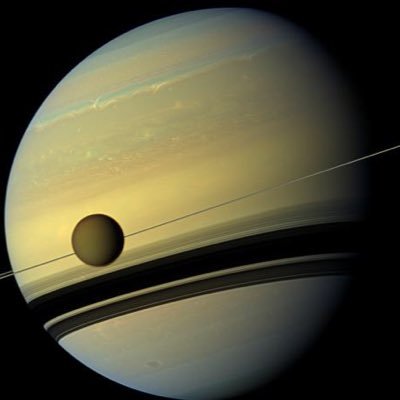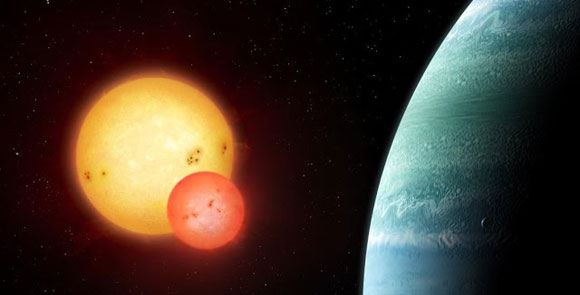Kepler 1647b
| Discovery | |
|---|---|
| Discovery site | Kepler Space Observatory |
| Discovery date | June 13, 2016 |
| Transit | |
| Orbital characteristics | |
| 2.7205 ± 0.007 AU (406,980,000 ± 1,050,000 km)[1] | |
| Eccentricity | 0.0581[1] |
| 1107.6±0.023[1]d | |
| Inclination | ~90.1[1] |
| Star | Kepler-1647 |
| Physical characteristics | |
| 1.06±0.0123 RJ | |
| Mass | 1.52±0.65 MJ |
Kepler-1647b (sometimes named Kepler-1647(AB)-b to distinguish it from the secondary component) is a circumbinaryexoplanet that orbits the binary star system Kepler-1647, 3,700 light-years (1,100 pc) from Earth in the constellation Cygnus.[2] It was announced on June 13, 2016 in San Diego at a meeting of the American Astronomical Society.[2] It was detected using the transit method, when it caused the dimming of the primary star, and then again of the secondary star blended with the primary star eclipse.[3]The first transit of the planet was identified in 2012, but at the time the single event was not enough to rule out contamination, or confirm it as a planet.[3] It was discovered by the analysis of the Kepler light-curve, which showed the planet in transit.
Sadly, we probably won't find Luke Skywalker on Kepler-1647b. With a mass and radius nearly identical to that of Jupiter, the planet called Kepler-1647b is 3,700 light-years away from Earth and approximately 4.4 billion years old, roughly Earth's age. Some active galactic nuclei (AGN) — accreting black holes at the centers of galaxies — exhibit broad emission lines in their spectra from high-velocity gas.
Characteristics[edit]
Kepler-1647 b is substantially larger than any of the previously known circumbinary planets. Using the Kepler Space Telescope, astronomers have identified the largest planet to date around a double-star system.
Mass and orbit[edit]
The exoplanet is a gas giant, similar in size to Jupiter, and has an orbital period of 1107 days.[3] This is the longest transit period of any confirmed transiting Kepler exoplanet discovered yet.[2] It is also the largest circumbinary Kepler planet known.[3] It is 483±206 times more massive than Earth, and 1.52±0.65 times Jupiter's mass.[1]
Host stars[edit]
The star system, Kepler-1647 (also known as 2MASS J19523602+4039222, KOI-2939, and KIC 5473556), is a binary star with the primary star (Kepler-1647 A) having a mass of 1.22 M☉, a radius of 1.79 R☉, and a surface temperature of 6210 ± 100 K. The secondary star (Kepler-1647 B), on the other hand, has a mass of 0.975 M☉, a radius of 1.79 R☉, and a surface temperature of 5770 K. In comparison, the Sun has a surface temperature of 5778 K.[4] The two orbit each other every 11 days.[5] The binary star system's age is estimated to be about 4.4 billion years old, about 200 million years younger than the Sun.
Habitability[edit]
Kepler-1647b is in the habitable zone of the star system.[2][3] Since the planet is a gas giant, it is unlikely to host life. However, hypothetical large moons could potentially be suitable for life.[2][3] Large moons are usually not created during accretion near a gas giant and would likely have to be captured separately, e.g., a passing protoplanet caught into orbit due to the gravitational field of the giant planet.

See also[edit]
References[edit]

- ^ abcde'Kepler-1647b – NASA Exoplanet Archive'. Retrieved June 14, 2016.
- ^ abcde'New Planet Is Largest Discovered That Orbits Two Suns'. NASA. June 13, 2016. Retrieved June 14, 2016.
- ^ abcdefKostov, Veselin B.; Orosz, Jerome A.; Welsh, William F.; Doyle, Laurance R.; Fabrycky, Daniel C.; Haghighipour, Nader; Quarles, Billy; Short, Donald R.; Cochran, William D.; Endl, Michael; Ford, Eric B.; Gregorio, Joao; Hinse, Tobias C.; Isaacson, Howard; Jenkins, Jon M.; et al. (2015). 'Kepler-1647b: the largest and longest-period Kepler transiting circumbinary planet'. The Astrophysical Journal. 827 (1): 86. arXiv:1512.00189. Bibcode:2016ApJ...827...86K. doi:10.3847/0004-637X/827/1/86.
- ^Fraser Cain (15 September 2008). 'Temperature of the Sun'. Universe Today. Retrieved 19 February 2011.
- ^'Planet Kepler-1647 (AB) b', exoplanet.eu, 2 December 2015, retrieved 26 July 2019
Coordinates: 19h 42m 36.02s, +40° 32′ 22.2″
External links[edit]
Kepler 1647b Distance From Earth
| Name | Kepler-1647 (AB) b |
| Planet Status | Confirmed |
| Discovered in | 2015 |
| Mass | 1.52 ( -0.65+0.65 ) MJ |
| Mass*sin(i) | — |
| Semi-Major Axis | 2.7205 (± 0.007) AU |
| Orbital Period | 1107.5923 (± 0.0227) day |
| Eccentricity | 0.0581 (± 0.0689) |
| ω | 155.0464 (± 146.5723) deg |
| Tperi | — |
| Radius | 1.06 ( -0.01+0.01 ) RJ |
| Inclination | 90.0972 (± 0.0035) deg |
| Update | 2016-10-14 |
| Detection Method | Primary Transit |
| Mass Detection Method | — |
| Radius Detection Method | Primary Transit |
| Primary transit | — |
| Secondary transit | — |
| λ | — |
| Impact Parameter b | — |
| Time Vr=0 | — |
| Velocity Semiamplitude K | — |
| Calculated temperature | — |
| Measured temperature | — |
| Hottest point longitude | — |
| Geometric albedo | — |
| Surface gravity log(g/gH) | — |
| Alternate Names | — |
Star
 Kepler-1647 (AB)
Kepler-1647 (AB)| Name | Kepler-1647 (AB) |
| Distance | — |
| Spectral type | |
| Apparent magnitude V | 13.78 |
| Mass | 2.1885 (± 0.01) MSun |
| Age | — |
| Effective temperature | 6210.0 (± 100.0) K |
| Radius | 1.79 (± 0.006) RSun |
| Metallicity [Fe/H] | — |
| Detected Disc | — |
| Magnetic Field | — |
| RA2000 | 19:52:36.0 |
| Dec2000 | +40:39:22 |
| Alternate Names | |
| Planetary system | 1 planet |
Remarks
2 Dec 2015: The parent star is an eclipsing binary with an orbital period 11 d. The mass given in this page is the sum of the primary and secondary masses. The full parameters are:
Star A: M = 1.22 ± 0.01 MSun, R = 1.79 ± 0055 RSun, T = 6210 u 100 K
Star B: M = 0.97 ± 0.0039 MSun, R = 0.966 ± 0055 R
Kepler 1647b Facts
Sun, T = 5770 u 125 KMore data
- Most recent references (ADS)
Remarks
02 Dec 2015: Three planetary transits have been observed as of Dec 2015, two for the primary star, the third one at the time of eclipse of the parent eclipsing binary star. The planet revolves around an 11-day period eclipsing binary (Kostov et al. 2015).Related publications
On the Detection of Habitable Trojan Planets in the Kepler Circumbinary Systems
2021 SUDOL J. & HAGHIGHPOUR N.
Astron. J., 161, 223
paperarxiv
Circumbinary habitable zones in the presence of a giant planet
2021 GEORGAKARATOS N., EGGL S. & DOBBS-DIXON I.
Frontiers in Astronomy and Space Sciences, accepted
arxiv
Multiple Transits during a Single Conjunction: Identifying Transiting Circumbinary Planetary Candidates from TESS
2020 KOSTOV V., WELSH W., HAGHIGHIPOUR N., AGOL E., FABRYCKY D. et al.
Astron. J., 160, 174
paperarxiv
Tidal evolution of circumbinary systems with arbitrary eccentricities: applications for Kepler systems
2020 ZOPPETTI F., LEIVA A. & BEAUGE C.
Astron. & Astrophys., 634, A12
paperarxiv
Could there be an undetected inner planet near the stability limit in Kepler-1647?
2019 HONG Z., QUARLES B., LI G. & OROSZ J.
Astron. J., 158, 8
paperarxiv
Orbital Evolution of a Circumbinary Planet in a Gaseous Disk
2019 YAMANAKA A. & SASAKI T.
Earth, Planets and Space, accepted
arxiv
Stability Limits of Circumbinary Planets: Is There a Pile-up in the Kepler CBPs?
2018 QUARLES B., SATYAL S., KOSTOV V., KAIB N. & HAGHIGHIPOUR N.
ApJ, 856, 150
paperarxiv
Secular Dynamics of Multiplanetary Circumbinary Systems
2017 ANDRADE-INES E. & ROBUTEL Ph.
Cel. Mech. & Dyn. Astron., 130
arxivpaper
Kepler-1647 b: the largest and longest-period Kepler transiting circumbinary planet
2016 KOSTOV V., OROSZ J., WELSH W., DOYLE L., FABRYCKY D. et al.
ApJ, 827, 86
arxivpaperADS

Circumbinary planets II - when transits come and go
2016 MARTIN D.
MNRAS, 465, 3235
paperarxivADS
Tatooine's Future: The Eccentric Response of Kepler's Circumbinary Planets to Common-Envelope Evolution of their Host Stars
2016 KOSTOV V., MOORE K., TAMAYO D., JAYAWARDHANA R. & RINEHART S.
ApJ, 832, 183
paperarxivADS
